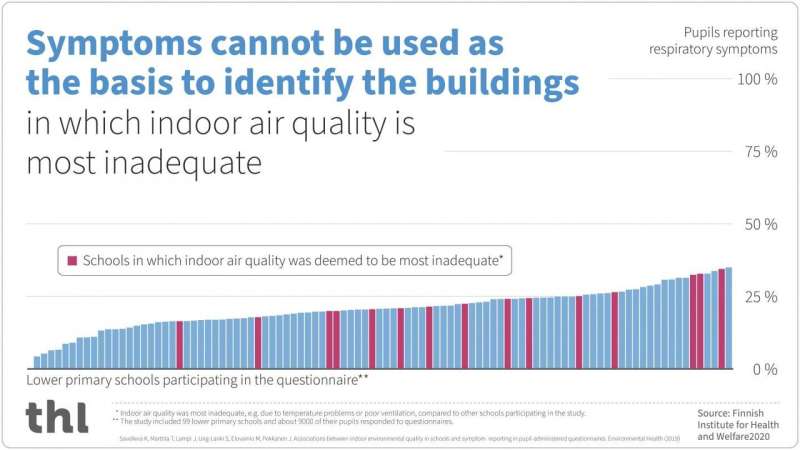School indoor air quality cannot be reliably assessed based on pupils' symptoms

In school buildings with indoor air quality related problems, such as moisture damage, temperature problems or poor ventilation, pupils experience slightly more symptoms than in buildings in which conditions are stated to be good based on expert evaluation.
However, the association between indoor air quality of the school building and the pupils' symptoms was so weak that it is not possible to reliably assess the quality of the indoor air based on the amount of reported symptoms. This was found in a recent study by the Finnish Institute for Health and Welfare and the University of Helsinki, which was published in the scientific journal Environmental Health.
The researchers found that inadequate indoor air quality was connected to the pupils' respiratory and general symptoms, such as colds, coughs and headaches. Some link to lower airway or skin symptoms was also found, but not to eye symptoms.
It is worth maintaining and investigating buildings
Earlier research also suggests that symptoms are not a good marker of the indoor air quality of a building.
"We need more research on how much indoor air impurities explain the differences in symptoms between schools, in comparison to other factors that influence symptoms. To date, these other factors have been remarkably little researched," said Professor Juha Pekkanen.
Besides indoor air, other factors that influence symptoms include the age of the person, their health and stress levels, including how well they are doing and feeling at work and school, and beliefs and concerns about the risks of poor indoor air. The fact that many issues influence people's symptoms in indoor environments needs to be considered when interpreting the results of indoor air questionnaires.
"Questionnaires aimed at building users provide valuable additional information for the management of indoor air quality problems. However, the decisions on renovations should be based primarily on data obtained by investigating the building," said Chief Physician Jussi Lampi.
The study included 129 lower and upper primary school buildings in the Helsinki area. The building conditions were assessed based on the City of Helsinki's evaluations. The Finnish Institute of Health and Welfare's indoor air questionnaire was used to gather data about pupils' symptoms. More than 12,000 pupils responded to the questionnaire. The response rate was 60%.
More information: Kateryna Savelieva et al, Associations between indoor environmental quality in schools and symptom reporting in pupil-administered questionnaires, Environmental Health (2019). DOI: 10.1186/s12940-019-0555-6

















